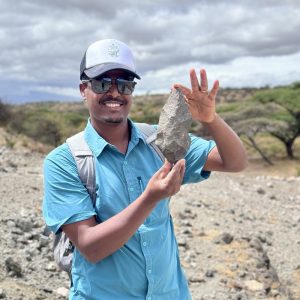
Tewabe Negash Kessaw
Summer 2024
Bones to Pick about Surviving a Supervolcano
A study published March 2024 in the journal Nature shares the discovery of a “trove” of 74,000-year-old stone points and fossil bones in Ethiopia that demonstrates the adaptability of early humans following a major disaster. Doctoral student Tewabe Negash Kessaw and Professor Michael Pante are part of the group that authored the study, led by John Kappelman of University of Texas. which suggests the points are the oldest known arrowheads and which were used to survive a supervolcano and its aftermath.
The Toba supervolcano erupted 74,000 years ago in Sumatra, Indonesia, covering Asia and Africa in ash and triggering a global volcanic winter that lasted up to a decade. Some scientists believe it caused a centuries-long cooling period and caused a genetic bottleneck among early human populations scrambling to find food, water, and shelter in an altered world. The Nature study offers evidence for how some early humans in Ethiopia survived and migrated through the cataclysmic conditions.
For the research, Negash analyzed gazelle, warthog, and giraffe bones found at the Shinfa-Metema 1 site, and Kessaw and Pante helped confirm that the cut marks were made by people using tools and resources from Pante’s 3-D Imaging Lab and the CSU Zooarchaeology Lab. Colleagues confirmed the trove of stone points and fossils corresponded to the time following the Toba supereruption. The findings and analysis suggest that the humans survived through “adaptive foraging,” including hunting these big game species with stone tools and projectile points.
The research has received attention from the New York Times and other outlets.
Meanwhile… at Olduvai
For his doctoral research, Negash has collaborated with fellow doctoral student
This summer, Prof. Michael Pante and doctoral students Alex Pelissero and Tewabe Negash Kessaw have returned to resume fieldwork and research at Olduvai Gorge in Tanzania – one of the foremost paleoanthropology sites in the world. Their research projects are using an array of tools and methods from field surveys to drone mapping to firsthand scavenging and re-creating bone tools in order to increase understanding about how early humans interacted and survived 1-1.9 million years ago.